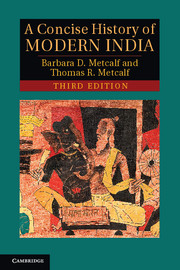Book contents
- Frontmatter
- Contents
- Illustrations
- Preface to the third edition
- Preface to the first edition
- Glossary
- Chronology
- 1 Sultans, Mughals, and Pre-Colonial Indian Society
- 2 Mughal Twilight: The Emergence of Regional States and the East India Company
- 3 The East India Company Raj, 1772–1850
- 4 Revolt, the Modern State, and Colonized Subjects, 1848–1885
- 5 Civil Society, Colonial Constraints, 1885–1919
- 6 The Crisis of the Colonial Order, 1919–1939
- 7 The 1940s: Triumph and Tragedy
- 8 Congress Raj: Democracy and Development, 1950–1989
- 9 Democratic India at the Turn of the Millennium: Prosperity, Poverty, Power
- Biographical notes
- Bibliographic essay
- Index
3 - The East India Company Raj, 1772–1850
Published online by Cambridge University Press: 05 November 2012
- Frontmatter
- Contents
- Illustrations
- Preface to the third edition
- Preface to the first edition
- Glossary
- Chronology
- 1 Sultans, Mughals, and Pre-Colonial Indian Society
- 2 Mughal Twilight: The Emergence of Regional States and the East India Company
- 3 The East India Company Raj, 1772–1850
- 4 Revolt, the Modern State, and Colonized Subjects, 1848–1885
- 5 Civil Society, Colonial Constraints, 1885–1919
- 6 The Crisis of the Colonial Order, 1919–1939
- 7 The 1940s: Triumph and Tragedy
- 8 Congress Raj: Democracy and Development, 1950–1989
- 9 Democratic India at the Turn of the Millennium: Prosperity, Poverty, Power
- Biographical notes
- Bibliographic essay
- Index
Summary
In 1772, determined at last to put an end to the chaos and fiscal disorder its intervention had precipitated in Bengal, the Company's directors appointed Warren Hastings, a man with a distinguished record of diplomatic and commercial service in India, as the first governor-general of the company's Indian territories. Subordinating the other presidencies to a new capital established in Calcutta, Hastings set about the task of creating an ordered system of government for British India. Hastings's thirteen years at the helm of government were far from untroubled. Indeed, throughout his years in office he had to contend with a divided council in Calcutta whose majority opposed his every move, while after his return to England his actions were made the subject of an embittered impeachment trial in the House of Commons. As a spectacle, for Hastings was ultimately acquitted, the trial dominated British public life for years. Nevertheless, Hastings laid an enduring foundation for the British Raj in India. This chapter will begin by examining the structures of governance established by Hastings, and his successor Lord Cornwallis (1785–93), in British-ruled Bengal. It will then ask how and why the British went on to conquer the entire Indian subcontinent in the first two decades of the nineteenth century, and it will conclude by assessing the relationships that grew up between what was known as the ‘Company Bahadur’, as though it were a Mughal grandee, and its Indian subjects in the years up to 1850.
Foundation of Colonial Rule
When Hastings took office, the East India Company's agents knew nothing about India apart from the requirements of trade, and they almost never ventured outside their coastal enclaves. With rare exceptions, among them Hastings himself, they knew no Indian languages. Within the existing British Empire, furthermore, rule over a vast indigenous population such as that of India was unprecedented. With the partial exception of Ireland, Britain's previous imperial expansion, in the West Indies and North America, had involved the dispossession of the native peoples in favour of settlers from Europe and Africa. Hence, as they confronted their new responsibilities in India, the British found themselves sailing in wholly uncharted waters. Their difficulties were further enhanced by the reluctance of the Company's agents in India to abandon their profitable trading activities for the uncertain advantages of government.
- Type
- Chapter
- Information
- A Concise History of Modern India , pp. 56 - 91Publisher: Cambridge University PressPrint publication year: 2012

